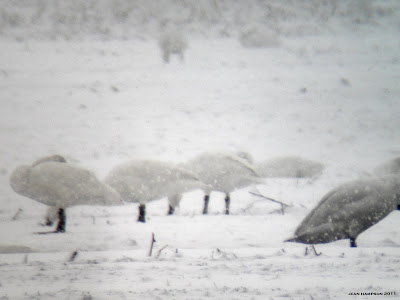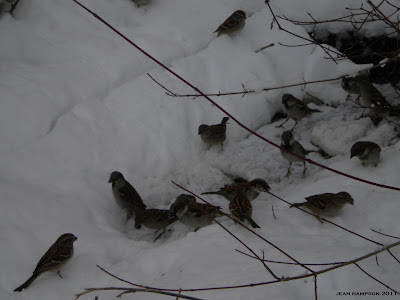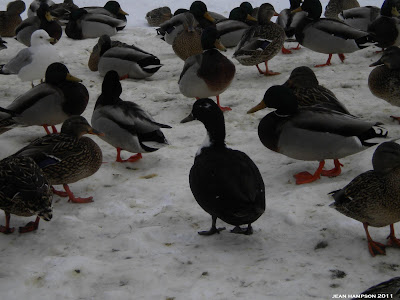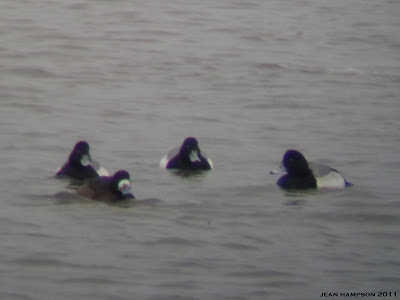Thursday, March 31, 2011
Chasing the Blues
Sunday, March 20, 2011
Today's Forecast, Snow and 10,000 Tundra Swans
Long Point during the month of March is an exciting place if you're a birder. Migrating waterfowl, swans and cranes pass through the area each year en route to their breeding grounds. Though Jean and I ticked Tundra Swan earlier this year while birding along the Niagara Parkway, I was looking forward to viewing the massive numbers of Tundra Swans in the fields and air during the OFO trip. E-mail reports informed ONTBIRDS subscribers that there were a staggering 10,000 Tundra Swans at Long Point. You could not see the water for the swans.
This was our third year of attending the Long Point OFO trip and instead of waking up early and driving for two hours to reach the St. Williams Forestry Station, we booked a bed & breakfast in Port Rowan. The same B&B we used for accommodation during the 2010 OFO Annual Convention. I took a vacation day on Friday and Jean and I planned to leave St. Catharines in the afternoon. Early Friday morning, our host at the B&B contacted us to ask if we still coming to Port Rowan. "It's snowing like crazy here!", the host informed Jean. That was a surprise to us, St. Catharines had no snow at all. The heavy snowfall raised concerns. Not for travelling but how the snow may hinder our chances of observing Sandhill Cranes. My concerns grew exponentially upon arriving in the small Norfolk County town. Along the way, we observed Tundra Swans in flight, 3 in Jarvis and 4 as we turned south towards Port Rowan on Regional Road 42. Would the morning snow storm have an affect on our swan viewing the next day?
Yikes! The harbour in Port Rowan was still frozen and covered with snow.


Unlike the 2009 trip, there was no way the small bay, west of the marina, would produce either phase of Snow Goose this year.

Looking towards the causeway we could see small pockets of open water containing small numbers of Tundra Swans.

More ice and snow when viewing the harbour from the bed and breakfast.

After an evening meal at a restaurant near the causeway, Jean and I drove along Long Point Road. We heard and observed Tundra Swans in the area surrounding Big Creek.
On Saturday morning, we woke to the calls of the nearby swans with no need to rush. The meeting place for the OFO trip was only a 10 minute drive. Add French toast with syrup from Oxford County and you could not ask for a better start to a day of birding.


Saturday's first sighting occurred during breakfast. Jean spotted a large bird flying over the harbour. It came to a rest on the ice and views through the scope supported our call of immature Bald Eagle.
Less than an hour later, we met our fellow OFO members and trip leaders (Jim Heslop, Bob Stamp & John Olmsted). No stops at Booth Harbour or Port Rowan this year. 18 cars started the search for a reported Greater White-fronted Goose.
The group stopped at Dedrick Creek. We found over 40 Canada Geese, including 2 in a tree, but no lifer Greater White-fronted Goose this day.

For Jean and I, we added two species to this year's Ontario list. A pair of Northern Shovelers were spotted in the background of the flooded field and Killdeers (3) announced their return to the Long Point area.

We moved on to Lakeshore Road, checking the fields west of Hwy. 59 until we reached Lee Brown Waterfowl Management Area. The fields on either side of the road are an excellent spot to find swans and migrating ducks. Horned Larks greeted us as we started our drive towards Port Royal. A Merlin was perched at the top of a tree along the side of the road and all had extended views of the small falcon. Small flocks of Tundra Swans flew overhead while hundreds and hundreds more were resting and feeding in the fields to the north.


In the flooded sections, Jean and I scoped a number of Redhead, Northern Pintail, and American Wigeon. To the south, our group's first observation of Sandhill Cranes. The cranes (3) were in flight and calling.





We moved north to where Concession Road 1 crosses Big Creek. No waterfowl in the swollen creek on the north side of the road. Looking south we found 1 American Wigeon and 1 Gadwall amongst the Canada Geese.

We moved on to Long Point and thanks to Bird Studies Canada, the group had access to the Old Cut Field Station during lunch. Luckily, I had the correct amount of cash on hand to place in the honour box to obtain a copy of Ron Ridout's, A Birding Guide to the Long Point Area. The guide has me planning to return and explore the Long Point area by ourselves to tick a lifer Northern Goshawk.
Tuesday, March 15, 2011
There's Aways the Niagara River
The day my Bird-A-Day challenge came to an end, a Great Horned Owl sighting was posted on the ONTBIRDS ListServ and I did not see the e-mail until later in the week. A few days had past since the sighting but I was anticipating that the owl may have a mate and was set to raise young in the Town of Fort Erie. If Jean and I could not find the Great Horned Owl, we could always take a side trip home along the Niagara River. That way, the day would not be totally wasted.

Saturday was a mild and damp day. The rain did not make it easy to scope a tree 100-150 metres away from where I stood. The nest appeared to be mostly leaves and as far as I could tell, it did not contain an owl. On a sunny day, I would have stayed a bit longer. It appeared to Jean and I that the owl was elsewhere. So we headed east to the Niagara River for a leisurely drive towards Chippawa.
The usual variety of ducks were encountered, each species preferring their own section of river when gathering in large numbers.

A small quantity of of Tundra Swans were observed this time. They will soon leave the region, possibly joining the thousands of swans at Long Point before heading to their breeding grounds in the Arctic.
Further down river, we paused to view an adult Bald Eagle perched in a tall deciduous tree. There are quite a few trees at this location, a preferred spot for resting Bald Eagles and we have found them here on two previous occasions this year.
A large float of Greater Scaup near Baker's Creek concluded our trip of searching for waterfowl along the upper Niagara. Nothing new was found between Fort Erie and Chippawa. Looks like a change of scenery is required. With early spring migrants on the move, it was time for the annual OFO trip to the Long Point area. 10, 000 Tundra Swans awaited our arrival the afternoon of Friday March 11. I was hoping there would still be room left for one or two Sandhill Cranes. A target species I could not afford to miss.
Tuesday, March 8, 2011
Bird-A-Day Challenge: It Was Fun While It Lasted

In addition to the usual species, there were a number of Redhead and a couple of Ring-necked Ducks. Both species were ticked along the Niagara River on previous occasions. In fact, the Redhead was chosen the day before after a failed attempt to find wintering Tundra Swans. A recent WNY Buffalo bird report on ontbirds indicated that the Tundras are still on the river. I simply picked the wrong spot to look for them. But apparently, luck was on my side the holiday Monday. To the naked eye, it appeared there were more Mute Swans than the usual pair. A closer look through the scope revealed that the six additional swans (adults and 1 juvenile) were another Cygnus species, Tundra Swans.








On Sunday, I thought a new spot that was not too far from St. Kitts might produce a waterfowl species I had yet to tick for the challenge.

Jean and I went to Vineland to look at the ducks on Lake Ontario, a stop for the MNR Duck Count. Waterfowl observed included White-winged Scoter, Long-tailed Duck, Bufflehead, Common Goldeneye, Red-breasted Merganser and the species I was looking for, Greater Scaup.




A male Long-tailed Duck diving while a female Greater Scaup is content with taking it easy.

For the moment, the scaup was the bird of the day. Travelling home, I drove along the rural roads in the Town of Lincoln, up and then down the Niagara Escarpment, in search of Eastern Bluebirds. Jean and I have not observed this species of thrush since the Port Colborne CBC on January 2. That day, a Rough-legged Hawk made the list.
No bluebirds on the Sunday afternoon drive but at the edge of a field, a member of the family Mimidae stood at the top of a small tree. Northern Mockingbird replaced the Greater Scaup for the bird of the day.
On Monday February 28, I returned to Vineland after work. The Greater Scaups were still there. Aythya marila was the last species for the Bird-A-Day challenge. The next day I had an appointment in the early evening and I decided the best chance of continuing the challenge in March was to look for a Herring Gull below Lock One on the Welland Canal. I had cast the dice. On previous visits, I observed Herring, Glaucous and Great Black-backed Gulls but this day, all I could find were Ring-billed Gulls standing on the ice. East of the canal, Jones Beach was no different. The distant gulls appeared to be Ring-billed as well. After one last futile attempt, driving home along the empty Welland Canal (water and gulls), my Bird-A-Day challenge came to an end. Even if I had observed a Herring Gull, I could not see it lasting much longer. One or two more ticks but I'm certain I could not have taken the challenge into an eighth week.
With the Bird-A-Day challenge set aside until next year, I can now work on adding species to the 2011 Ontario list. Thankfully, there are some OFO trips and BOS counts coming up. February was slow for additions but that was due to a well birded January. Jean and I currently stand at 75 species, a number we did not reach until March 21 last year. In addition to the trips, the ontbirds report will be helpful, especially if the reported bird, one such as a Great Horned Owl, is in the Niagara Region.
Tuesday, March 1, 2011
Fleeting Ticks
Another weekend but this time, I had an extra day. The provincial holiday, known as 'Family Day' would give some additional spare time to actively search for a species that I do not come across every day.
On the 19th, I visited the feeders on the Merritt Trail and observed a Red-bellied Woodpecker in the trees beside the gravel path. The next day, I travelled to the Upper Niagara River. I had still not ticked Tundra Swan and I was certain this would be a no hassle tick. With the recent thaw, I thought the section of river near Miller's Creek would be free of ice. Well, it was definitely clear of ice. But to my surprise, there were only two swans present.

Mute Swans.

Was I too late? Had the Tundras left Niagara? From the roadside, I looked at the waterfowl on the river and found two species that I could use for my challenge. After choosing Redhead over Greater Scaup, I attempted a bit of digiscoping.



Heading back to St. Catharines, I thought of places that I could visit on the holiday Monday. Not only would it have to produce a species that was not already on the Bird-A-Day list, it would have to be a spot that involved a minimum amount of travel. With no spares left, my days just might be numbered.










